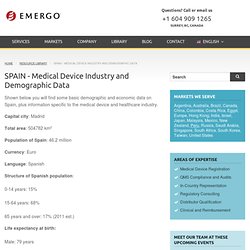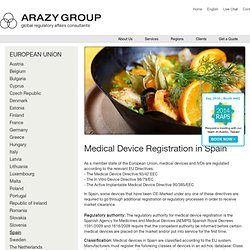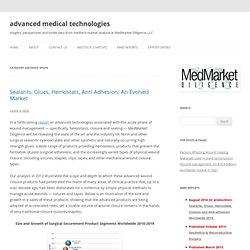

The role of industry in innovation for health processes by Alejandra … Pharmaceutical HTA and Reimbursement Processes - Spain. Medical Device Market Access: Optimising Medical Device and Diagnosti… Spain: New regulations for medical devices. On 6 November 2009, two new regulations reshaping the framework for medical devices were published in the Spanish Official Gazette.

Royal Decree 1591/2009, on Medical Devices, and Royal Decree 1616/2009 on Active Implantable Medical Devices are the result of the implementation of European provisions (including amendments made by Directive 2007/47/EC to Directive 93/42/EC on Medical Devices) as well as adaptation to national Law 29/2006 on Medicines.
These new regulations will come into force from 21 March 2010. Until then, authorisation, certification and notification proceedings will continue to be carried out according to Royal Decree 414/1996 (the regulation to be repealed by the new regulations). The medical devices sector is becoming particularly important in Spain, with more than 12,000 operative companies, 30,000 working professionals and a turnover breaking the EUR 6,000 million barrier (8.6 % of European market share). Portuguese National Registration. Any physical or legal entity has to notify the Spanish Authority "Agencia Española de Medicamentos y Productos Sanitarios (AEMPS)" prior to bringing Medical Devices of risk class IIa, IIb or III on the Spanish market or putting them into service in Spain for the first time (chapter 6, article 22, Royal Decree (RD) 1591/2009).

In-Vitro Diagnostic Device and Medical Device manufacturers who are located outside the EU are obliged to designate an Authorized Representative (article 24, RD 1591/2009). The Spanish national registration will be done electronically, by the Authorized Representative, via an online databank established by the Spanish Authority. Appoint MDSS to perform the. CE mark medical device - medical devices CE marking. Folleto-regulacion_Med-PS.pdf. SPAIN - Medical Device Industry and Demographic Data.
Shown below you will find some basic demographic and economic data on Spain, plus information specific to the medical device and healthcare industry.

!!!! MDDI Medical Device and Diagnostic Industry News Products and Suppliers. Subscribe | login or register View All Topics We surveyed our readers, and the responses are in.

See where you fit in amongst your peers in many aspects surrounding job satisfaction in the 2013 salary survey. 3 Trends Shaping The Evolving Medtech Market. Medical Device Registration in Spain, Medical Device Consultants Spain, Medical Device Approval Spain. As a member state of the European Union, medical devices and IVDs are regulated according to the relevant EU Directives: - The Medical Device Directive 93/42 EEC - The In Vitro Device Directive 98/79/EC - The Active Implantable Medical Device Directive 90/385/EEC In Spain, some devices that have been CE-Marked under any one of these directives are required to go through additional registration or regulatory processes in order to receive market clearance.

Regulatory authority: The regulatory authority for medical device registration is the Spanish Agency for Medicines and Medical Devices (AEMPS) Spanish Royal Decrees 1591/2009 and 1616/2009 require that the competent authority be informed before certain medical devices are placed on the market and/or put into service for the first time.
Advanced medical technologies. The worldwide market for products in wound management, as reflected in the MedMarket Diligence report #S249, encompasses twelve discrete product segments: Traditional Adhesive DressingsTraditional Gauze DressingsNon-Adherent DressingsFilm DressingsFoam DressingsHydrogel DressingsHydrocolloid DressingsAlginate DressingsAntimicrobial DressingsNegative Pressure Wound Therapy DevicesBioengineered Skin and Skin SubstitutesWound Care Growth Factors These segments include traditional wound care products, like dressings and bandages, but also include their more evolved forms with embedded components or constructions to enhance wound healing by shortening healing times or improving outcomes.

But, wound care has also evolved to included equipment/device-mediated care as in NPWT as well as biologically-derived or engineered products in regenerative medicine. The world market in 2012 stood at approximately $12.45 billion. Health Status. Newsroom. 30/06/14 – Health spending has started to rise again after stagnating or even falling in many OECD countries during the crisis.

But the pace of growth remains well below pre-crisis rates, especially in Europe, according to OECD Health Statistics 2014. Overall health spending accounted for 9.3% of GDP on average across OECD countries in 2012, little changed from 9.2% in 2011, but up from 8.6% before the crisis. Newsroom. Health expenditure, total (% of GDP) Most Efficient Health Care: Countries - Bloomberg Best (and Worst) Overview Bloomberg ranked countries based on the efficiency of their health-care systems.

Methodology Each country was ranked on three criteria: life expectancy (weighted 60%), relative per capita cost of health care (30%); and absolute per capita cost of health care (10%). Countries were scored on each criterion and the scores were weighted and summed to obtain their efficiency scores. Relative cost is health cost per capita as a percentage of GDP per capita. Source(s) World Bank, International Monetary Fund, World Health Organization, Hong Kong Department of Health. The World Factbook. Spain Physicians density - Demographics.
HealthcareSpain_MedFB.pdf. Global Health Observatory Data Repository. Whsesp-spain.pdf. Imaz.pdf. Plataforma AETS/ISCIII - AUnETS. IP9_SarriaSantameraAntonio.pdf. Cuts drive health system reforms in Spain. Open Access Abstract The economic crisis is largely shaping health policy in Spain.

This paper reports on major changes in the health care system, both nationally and regionally, as a consequence of sizable cutbacks and new pieces of legislation. The most relevant changes to the system introduced during the last year are having an impact on who is insured, which benefits are covered, and what share of the cost of service provision is contributed by the population, while at the same time reducing salaries and working conditions in the sector.
We further report on the consequences these changes are having, and the roles played by key actors and organisations in the system. Health expenditure indicators - OECD Health Data: Health expenditure and financing. Health-at-a-Glance-2013.pdf. Estudio sobre la sostenibilidad del sistema sanitario público en España y sus comunidades autónomas. El estudio El sistema sanitario público en España y sus comunidades autónomas: Sostenibilidad y reformas, publicado la Fundación BBVA y el Ivie, ofrece un diagnóstico de la sostenibilidad del sistema sanitario público español y un análisis de las principales vías de reforma abiertas en la actualidad.

IHS Top 10 Healthcare and Pharma Industry Drivers for 2013. As 2012 draws to a close, the IHS Healthcare and Pharma team has taken the opportunity to look at the upcoming developments in R&D, P&R, M&A (and more) and put together our top-10 key pharma industry drivers for 2013. Below is our top 10 list, and to read more about each of the key drivers, download the full presentation. 2012 itself was of course a very busy year: it saw the removal of one of the key obstacles to implementation of healthcare reform in the US whilst there was continuing turmoil and reform in Europe – the non-launch of several key new drugs in Germany following the AMNOG reform was only the tip of the iceberg.
On the new technology front, we saw the first approvals for many years in the obesity market, whilst there were continuing disappointments in race to develop new Alzheimer’s therapies. Top 10 pharma industry drivers for 2014 by IHS Healthcare & Pharma. Diez-temas-candentes-sanidad-2013.pdf. Need surgery? Come to Spain. A world-class health system, prices below the European average and temperatures above it: Spain has all the ingredients to establish itself as a leading international healthcare and medical tourism destination. But it has taken an unprecedented recession to finally prompt the country's private clinics to begin trying to attract wealthy foreign patients either willing to pay for cosmetic surgery out of their own pockets, or have medical insurance that covers treatment in other countries.
Medical tourism is worth around 75 billion euros worldwide, according to the Organisation for Economic Co-operation and Development (OECD), which describes the sector as one with "further economic potential. " Tour operators, business leaders, private hospitals, and state health authorities all agree that Spain has what it takes to be a leading player. Spain has gained prominence for its medical system," says one US provider The company's website explains the cost benefits of undergoing surgery in Spain. Lucintels PESTLE Analysis of Spain: Country to Grow at a Slight CAGR over the Next Five Years. Lucintel’s PESTLE Analysis of Spain: Country to Grow at a Slight CAGR over the Next Five Years Irving, TX, August 15, 2013 --(PR.com)-- Plagued by a high fiscal deficit since 2009, the Spanish economy is expected to experience a slow growth rate and reach an estimated $1.42 trillion at the current prices by 2018.
Spain’s high fiscal deficit had led to high sovereign debt of the economy, placing Spain at a disadvantageous position as compared to other European Union nations. As per Lucintel’s estimate, Spain’s economy is expected to continue decelerating throughout 2013 due to weak external demand and the consolidation measures taken by government to reduce the general government deficit to 6.3% of GDP during 2013. Lucintel, a leading global management consulting and market research firm, has conducted a competitive analysis on the various growth opportunities and risk factors associated with the country and presents its findings in “PESTLE Analysis of Spain 2013.”
Bases de datos - Economía y Sociedad - Áreas. Informe - El sistema sanitario público en España y sus comunidades autónomas: sostenibilidad y reformas. Health care in Spain: Is Spain on the verge of a public health-care crisis? EARLIER this year, an immigrant in Spain was not feeling well and went to hospital with symptoms of tuberculosis (TB). He was refused tests and sent home. Not much later he felt so bad that he rushed to the emergency room where again he was turned away. Then he died. Like many illegal immigrants, the man lived in a small space with ten others. As TB is a contagious disease, all ten are now also at risk. A paper published on December 14th in the Lancet, a medical journal, sounded an alarm on the state of Spanish health care. As the crisis hit, the Spanish government cut spending on an already relatively lean health-care system. Elena Urdaneta, from Doctors of the World, a non-profit organisation, says the policy is not only unfair but also extremely dangerous for public health.
Spain environment.pdf. OECD Economic Survey of Spain 2014. Ee2_en.pdf. Le-march-des-dispositifs-m-dicaux-etude.pdf. HC-comparison-updated.pdf. Global Economic Outlook Q3 2013: Eurozone consumer trends. European consumers have been confronted with tough economic conditions for more than half a decade now due to three crises: the financial crisis, the euro crisis, and the recession. The prospects for a recovery in Europe critically hinge on consumer behavior and how it will develop as it represents the largest part of GDP in the Eurozone.
With considerable differences between the member countries, individual consumption accounts for around 70 percent of GDP in the Eurozone.1 What distinguishes the current recession from cyclical recessions is not only the length and depth, but also the unusually high economic uncertainty and its negative impact on consumption. Among the four big Eurozone economies—Germany, France, Italy, and Spain—consumers deal very differently with this situation. This is mainly due to two reasons. First, disposable income patterns have been diverging after the financial crisis. Disposable income and consumption trends. Population ageing. In a number of countries the combination of increasing life spans and low birth rates is accelerating the rate at which the share of older people in the population is rising. As a result, the population as a whole is getting older.
These longevity gains are due to improvements HIGHLIGHTSFundación General CSIC Analysis Unitin quality of life, and in particular, to the advances medical science has made in recent decades. Infsns2012. PUBLICACION_SIAE_2012.pdf. PUBLICACION_SIAE_2012.pdf. Population structure and ageing. Data from May 2014. Most recent data: Further Eurostat information, Main tables and Database. Spainbusiness. The_emti_in_fig_broch_12_pages_v09_pbp.pdf. Diabetes Prevalence - Country Rankings. Prevalence estimates of diabetes mellitus, 2010 by Country Percent of adult population with diabetes, ranked highest to lowest % a. Population number as described in the CIA World Factbook 2008, with growth and age distribution adjustment to that of world population from 2008 to 2010, except Taiwan (developed world population) b.
For New Caledonia, the Melanesian population was ascribed as having the national urban/rural population distribution, whereas the French population was deemed as having the diabetes prevalence of Metropolitan France, and assigned to the urban component, and each assigned 50% of the total population c. CNH2013. CNH2011. e94549. Ministerio de Sanidad, Servicios Sociales e Igualdad - Portal Estadístico del SNS - Sistema de Información Sanitaria: Portal Estadístico del SNS - Indicadores Clave del Sistema Nacional de Salud: INCLASNS – BD. Los Indicadores Clave del Sistema Nacional de Salud son un conjunto priorizado de información que abarca los aspectos considerados más relevantes de la salud y del sistema sanitario español. La selección de indicadores se ha realizado por consenso entre las administraciones representadas en el Consejo Interterritorial del SNS.
Ministerio de Sanidad, Servicios Sociales e Igualdad - Organizacion Institucional - Sistema Nacional de Salud. Ministerio de Sanidad, Servicios Sociales e Igualdad - PortalEstadístico del SNS - Búsqueda de microdatos. Ministerio de Sanidad, Servicios Sociales e Igualdad - Statistical Site of the NHS - Data bank. Informe_analisis_situac2013_ing_0.pdf. Healthcare statistics. Data from January 2014. Most recent data: Further Eurostat information, Main tables and Database. Spainreport. Instituto Nacional de Estadística. (National Statistics Institute) Instituto Nacional de Estadística. (National Statistics Institute) Data and statistics.
Spain GDP. Spain - Health expenditure. Health expenditure, private (% of GDP) Health expenditure, private (% of GDP) in Spain was 2.49 as of 2011. Its highest value over the past 16 years was 2.49 in 2011, while its lowest value was 2.02 in 1997. Spain - Urban population. Spain.pdf. Europe Spain Map. Spain Map Population Density Regions. Spain.